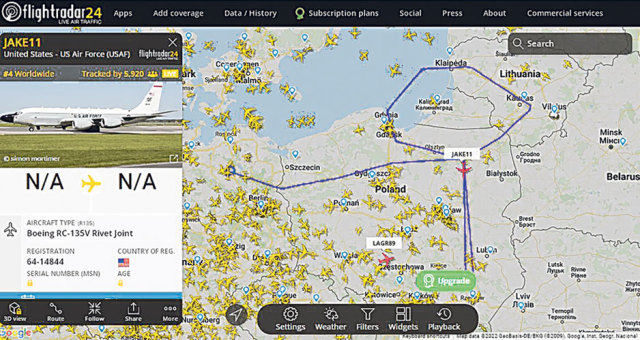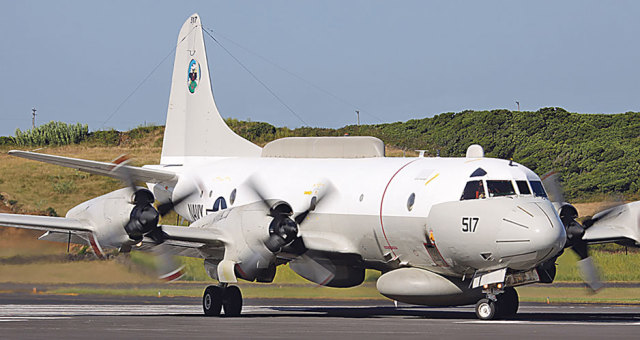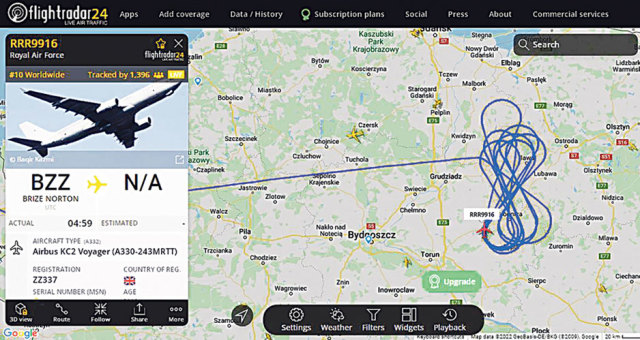The United States makes maximum use of the situation in Ukraine to gain experience in the operation of RTR and electronic warfare aircraft against the Russian Aerospace Forces
The skies of Europe, or rather the countries bordering Belarus, Ukraine and Moldova, are patrolled by reconnaissance aircraft. And NATO tankers of various types are constantly hanging in the air. Monitoring of the routes of the alliance's military aircraft over the past two weeks shows that since the beginning of the special operation of the Russian Armed Forces in Ukraine, areas of patrol and reconnaissance have been clearly defined for NATO aircraft. On the Flightradar resource, you can find the flight routes of these aircraft at any time. Usually they have only an alphanumeric call sign. The landing airfield is not indicated, but the departure point is either indicated, or it can be tracked along the trajectory on the map.
What are NATO planes looking for along Russia's borders
Flytradar is an online service that allows you to track the movements of all planes and helicopters in the world in real time, if an ADS-B transponder is on board. On the resource, you can track the coordinates of the aircraft, altitude and flight speed, route and departure point. The aircraft type, flight number, country and airline affiliation, and landing place are also indicated. You can also view an archive record of the flight of a particular aircraft.
The main patrol areas of scouts and tankers are the central regions of Poland, the border areas of Poland and Romania with Belarus and Ukraine, as well as the border areas of Romania and Moldova. And of course, the Baltic States. But the most interesting thing is that in the districts of Brasov in Romania and between the Polish cities of Lublin, Rad and Czestochowa, NATO tankers – KC-135, Airbus A330 and KC-10 - are constantly barraging.
Even in the skies of Romania and Poland, all kinds of "trucks" of the NATO Air Force are constantly cruising. Sikorsky UH-60M Blackhawk multipurpose helicopters of the American Army are flying near the borders of Ukraine and Belarus. Over the past few days, Ukrainian transport workers have been spotted in this part of Europe, making shuttle flights from the capital of Ukraine and Uzhgorod to the Siauliai (Latvia) and Emory (Estonia) air bases.
Who are the tankers
According to the American classification, the letters KC denote an air tanker based on a military transport or civilian aircraft.
The American KC-135T Stratotanker is a tanker based on the C-135 Stratolifter four-engine transport aircraft, created back in the early 50s.
The tanker is able to give away more than 90 tons of fuel. On the basis of the C-135, the well-known passenger Boeing-707 was also created. But the main alteration of the C-135 veteran is, of course, the Boeing RC-135V Rivet Joint scout.
"The command of the NATO Joint Forces in Europe and the American command make the most of the situation in Ukraine to gain experience in the work of RTR and electronic warfare against the Russian Armed Forces and VKS”
The American McDonnell Douglas KC-10A Extender is a tanker based on the McDonnell Douglas DC-10 passenger three-engine aircraft. By the way, the KC-10 can also operate as a transport aircraft, carrying over 75 people and about 76.5 tons of cargo.
The European Airbus KC2 Voyager was created on the basis of the passenger A330-200 under the MRTT (Multi Role Tanker Transporter) program. It is capable of refueling two aircraft at the same time. The A330 MRTT carries 110 tons of fuel and can at the same time take on board 45 tons of cargo additionally. The KC2 is equipped with both a rod refueling system and a hose-cone system. It has ventral (Cobham 805E) and underwing (Cobham 905E) refueling units. Moreover, it is equipped with a UARRSI installation for refueling itself from another tanker.
Why can NATO tankers barrage in the border areas? When conducting combat operations, they refuel tactical fighters to increase their range and duration of operation directly in the combat area. One of the main functions of tankers is refueling long-range strategic bombers operating from bases remote from the conflict site. Refueling increases their range of action for striking in strategic rear areas and for returning to their base.
Now about the scouts. The routes of their flights clearly indicate the areas of interest of the NATO military.
Assorted scouts
Heavy, medium and small reconnaissance aircraft, electronic warfare aircraft and other "flying electronics" operate in the border areas. Let's start with the big ones.
Boeing RC-135V Rivet Joint of the American Air Force with the call sign JAKE11 (registration number 64-14844) operates on an elongated route in Poland. He makes the first circle, completely flying around the Kaliningrad region via Klaipeda, Kaunas and Gdansk. Then it occupies a patrol zone from north to south along the Belarusian and Ukrainian borders.
RC-135 is the main aircraft of the US Air Force radio intelligence. It can conduct reconnaissance in all radio bands and track the work of the SAM and air defense radars. Flying along the Bialystok - Lublin -Rzeszow line, it scans the territory of Belarus and Ukraine. The maximum approach of the scout to the border of Belarus near Brest is about 100 kilometers. The flight altitude is optimal for patrolling and scanning - about nine to ten thousand meters. The configuration of the scout's flight shows that he is interested in stationary and mobile military facilities in the western regions of Belarus and Ukraine. Most likely, the Americans share intelligence with their junior partners - the APU, and also monitor the situation in their interests. The radio reconnaissance aircraft can also locate and transmit data on communication nodes, control points, air defense points and issue target designation data to ground and air weapons.
The RC-135 aircraft is a mobile aerial reconnaissance center. 12-16 operators use the MUCELS system to conduct radio surveillance of interceptions performed by enemy fighters and air defense networks. Three operators of the AEELS (Automatic Electronic Emitter Location System) system monitor the location of air defense systems and aircraft in the desired area. Seven intelligence officers monitor radar emissions from air, land and sea-based facilities. And there are also three air and ground situation analysts and one cryptographer operator on board to transmit data to the ground (air) coordination headquarters.
The basis of the RC-135 avionics are electronic and radio intelligence complexes. One of them is designed to intercept, decrypt and analytically evaluate enemy radio communications, intercept enemy data packets with information about the tactical situation transmitted through secure channels between surface, ground and air combat units.

Photo: google.com
For example, the RER 85000 complex, known under the index ES-182 MUCELS (Multiple Communication Emitter Location Systems), can intercept radio channels for transmitting information about the air situation from A-50 AWACS aircraft to consumer terminals (Su-27CM/30CM and Su-35C). The equipment of the ES-182 complex has an average signal detection and interception range of about 900 kilometers. But most likely there are no possibilities to decipher it yet. Due to the use of the RF Armed Forces of the pseudorandom adjustment mode of the operating frequency, such capabilities are not available to decoder operators and decryption software of RC-135 on-board working terminals.
Lockheed EP-3E Orion. The base for it was the US Navy patrol aircraft P-3 Orion. And for him, in turn, the prototype was the Lockheed L-188 Electra passenger aircraft, which was released back in 1957.
Let's allow ourselves a small digression from the main topic. Americans constantly use aircraft produced in the 50s-60s-70s. Age-old aircraft are being upgraded, equipped with modern engines and avionics, extend their service life and continue to operate. There are many examples, for example, a strategic bomber based on a veteran of many wars, the B-52, or all the same RC and KC based on the C-135 of the 50s of development.
Let's go back to the Orion scout. The EP-3E became the standard long-range electronic reconnaissance aircraft of the US Navy. The main equipment of the aircraft is the AN/ALR-76/504 electronic warfare system with ESM electronic countermeasures equipment, Radar Warning Receiver (RWR) radiation warning system and Electronic Intelligence (ELINT) electronic intelligence complex.
The equipment also includes an AN/ALR-66A/B(V) electronic detection system3 in combination with the EP-2060 Pulse Analyzer, the AN/ALQ-78A RTR counteraction system. The crew of the aircraft consists of two replacement main crews and 15 operators.
What are the dangers of aerial spies
During the special operation, the Russian aviation uses the means of exchanging tactical information. They allow pilots to track the location of both their own and other aircraft in real time on the IFI, as well as receive target designation from AWACS aircraft. These tools use radio channels protected by code and pseudorandom tuning of the operating frequency.
The operators of the EP-3E reconnaissance aircraft hunt for the frequency parameters of the operation of these radio channels. The powerful AN/ALR-76/504 RTR/EW complex for detecting the operating modes of enemy ground-based ship and air radars is complemented by the AN/ALR-66A/B(V)3 electronic reconnaissance complex with the EP-2060 Pulse Analyzer terminal for bearing and decryption of protected tactical communication channels. With the help of these means, EP-3E operators can attempt to analyze our radio channels for further development of actions to suppress operational and tactical radio communications between aircraft and helicopters of the Russian Aerospace Forces and AWACS aircraft, as well as ground information exchange points.
The operators of the reconnaissance aircraft are trying to read and decrypt the communication channels on which the aircraft of the Russian Aerospace Forces operate in order to suppress them if necessary.
The EP-3E aircraft with the call sign TD45 takes off from the airport of Chania (Crete) and operates along the borders of Moldova on the route Constanta – Galac – Vaslui – Suceava and back. Another scout, the Bombardier Challenger 650 with the call sign CL60, operates along the same route. Only he makes a U-turn over Suceava and goes west to the town of Shimleu-Silvania, there he turns around and takes the return route. Here, not far from the scout routes, a US Air Force tanker from Ramstein Boeing KC-135T Stratotanker with the call sign LAGR236 is patrolling along a trajectory stretched from north to south.

Lockheed EP-3E Orion. Photo: airliners.net
A little more about the Challenger 650 Artemis scout. Officially, the aircraft is not in service, it is in the "pilot operation" stage. And now it is being tested in combat conditions. According to some reports, Bombardier Challenger 650 Artemis reconnaissance and targeting aircraft belong to private companies working for the Pentagon under contract. In total, the US Air Force has two such boards. One with the tail number N488CR belongs to Lasai Aviation LLC, and the second - No. N9191 - Tenax Aerospace LLC. Pilots for the scout are provided by companies under contract with the US Army, and special equipment operators are intelligence officers. The aircraft is designed to replace the outdated Beechcraft RC-12X Guardrail army scout. By the way, such a person is still patrolling the border with Belarus in Latvia, flying to the Kaliningrad region. The callsigns are YANK01 or YANK02, Siauliai Air Base.
Such is the tendency of the US command to convert civilian jets with a long range and duration of flight into tactical scouts. One such converted Gulfsteram IV (a well-known commercial business jet of Gulfstream Aerospace Corporation) of the Swedish Air Force operates daily in the Baltic Sea near the borders of Latvia and Lithuania to the borders of the Kaliningrad region (call sign SVF622, Linkoping airfield, Sweden).
In the summer of 2021, the American company L3Harris Technologies conducted the first flight tests of the ARES (Airborne Reconnaissance and Electronic Warfare System) reconnaissance and electronic warfare aircraft. The main tasks facing the crew of the aircraft are the fight against the enemy's electronic means. On board the aircraft is the HADES complex (High Accuracy Detection and Exploitation System – "High-precision detection and operation system"). A set of sensors detects ground targets for artillery and ballistic missiles. ARES automatically transmits their coordinates in real time to ground artillery, missile units and facilities that use high-precision long-range weapons. And this is not just passive radio intelligence, but a complex for combat use.
The command of the NATO Joint Forces in Europe and the American command make the most of the situation in Ukraine to gain experience in the work of RTR and electronic warfare against the Russian Armed Forces and VKS. Receive radio technical information about the work of the Russian Army. They are working out options for the use of ground strikes, including high-precision ones, and also keep fuel tankers on hand in the skies of Eastern Europe for possible refueling of strategic bombers and tactical fighters.
Valery Smirnov
The newspaper "Military-Industrial Courier", published in issue No. 10 (923) for March 22, 2022

